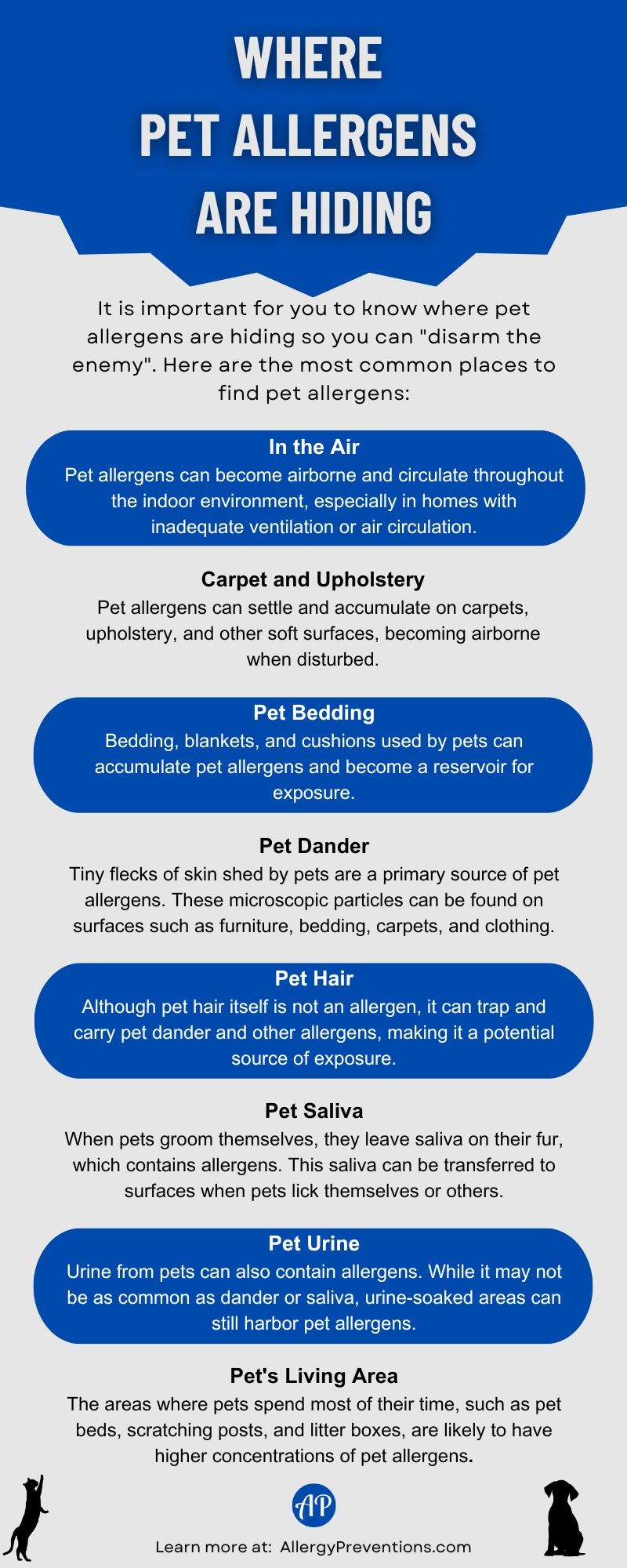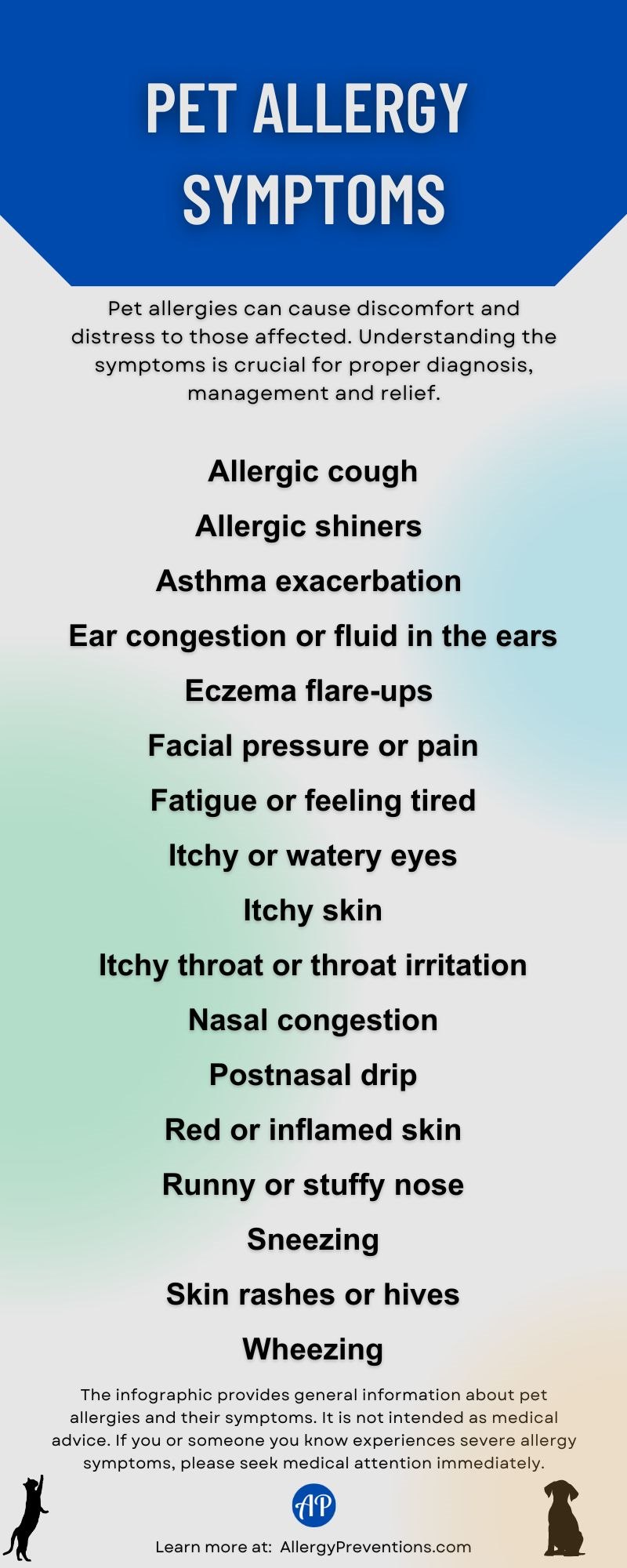Having a pet is an incredibly rewarding and joyous experience, but if you are like me and suffer from pet allergies, it can also be a source of distress. Pet allergies are a common issue worldwide, and it seems that this issue is only getting worse. But don’t worry, we will delve into the world of pet allergies, their symptoms, causes, and the various strategies I use to manage my symptoms while maintaining a healthy and loving relationship with my pets.

Table of Contents
What Are Pet Allergies?
Pet allergies are an immune system response triggered by exposure to certain proteins found in the saliva, urine, or dander (dead skin flakes) of animals. Common allergy-causing pets include cats, dogs, rabbits, birds, and rodents. When a person with allergies comes into contact with these proteins, their immune system overreacts, releasing histamines that lead to various allergic symptoms.
Types of Pets That Can Cause Allergies
Allergies to pets are triggered by dander, saliva, urine, or other allergens that pets may carry. There are several types of pets that can cause allergies in some individuals. These pets include:
- Birds (e.g., parrots, cockatiels)
- Cats
- Chinchillas
- Cows
- Dogs
- Donkeys
- Ferrets
- Gerbils
- Guinea pigs
- Hamsters
- Horses
- Mice
- Ponies
- Rabbits
- Rats
- Reptiles
The Deal with “Hypoallergenic Pets”
A hypoallergenic pet refers to an animal that is less likely to cause allergic reactions in individuals who are prone to pet allergies. While no pet is entirely hypoallergenic, some breeds produce fewer allergens compared to others. These pets typically have coats that shed less, which reduces the amount of allergens, such as dander, saliva, and urine proteins, released into the environment.
Check out the best hypoallergenic pets, if you have pet allergies but still would like to get a pet. It’s important to note that individual responses to hypoallergenic pets can still vary, and some people may still experience allergic reactions despite choosing a hypoallergenic breed. Before adopting a pet, especially if you have allergies, spending time with the animal to gauge your sensitivity is recommended to ensure a compatible and comfortable living environment.
Where are pet allergens found?

Pet allergens are found in various places where pets live, as well as in areas where they have been, even after the pet has left. Common sources of pet allergens include:
- Airborne Particles: Pet allergens can become airborne and circulate throughout the indoor environment, especially in homes with inadequate ventilation or air circulation.
- Carpet and Upholstery: Pet allergens can settle and accumulate on carpets, upholstery, and other soft surfaces, becoming airborne when disturbed.
- Pet Bedding: Bedding, blankets, and cushions used by pets can accumulate pet allergens and become a reservoir for exposure.
- Pet Dander: Tiny flecks of skin shed by pets are a primary source of pet allergens. These microscopic particles can be found on surfaces such as furniture, bedding, carpets, and clothing.
- Pet Hair: Although pet hair itself is not an allergen, it can trap and carry pet dander and other allergens, making it a potential source of exposure.
- Pet Saliva: When pets groom themselves, they leave saliva on their fur, which contains allergens. This saliva can be transferred to surfaces when pets lick themselves or others.
- Pet Urine: Urine from pets can also contain allergens. While it may not be as common as dander or saliva, urine-soaked areas can still harbor pet allergens.
- Pet’s Living Area: The areas where pets spend most of their time, such as pet beds, scratching posts, and litter boxes, are likely to have higher concentrations of pet allergens.
It’s important to note that pet allergens can persist for extended periods, even after the pet has been removed from the environment. Regular cleaning, allergen reduction strategies, and air purification can help minimize exposure to pet allergens and manage pet allergies more effectively.
Common Symptoms of Pet Allergies

Pet allergies can manifest in a range of symptoms, which may include sneezing, runny or stuffy nose, itchy and watery eyes, coughing, wheezing, and hives. Here is a list of common pet allergy symptoms:
- Allergic cough
- Allergic shiners (dark circles under the eyes)
- Asthma exacerbation (worsening of asthma symptoms)
- Ear congestion or fluid in the ears
- Eczema flare-ups (in individuals with existing eczema)
- Facial pressure or pain
- Fatigue or feeling tired
- Itchy or watery eyes
- Itchy skin
- Itchy throat or throat irritation
- Nasal congestion
- Postnasal drip
- Red or inflamed skin
- Runny or stuffy nose
- Sneezing
- Skin rashes or hives
- Wheezing
It’s important to note that the severity and specific symptoms of pet allergies can vary from person to person. If you experience any of these symptoms after being exposed to pets, it’s essential to consult with a healthcare professional for proper diagnosis and management.
Complications of Pet Allergies
Pet allergies can lead to various complications, especially if left untreated or if there is continued exposure to pet allergens. Common complications include chronic sinusitis, respiratory infections, asthma exacerbations, skin infections, and eczema flare-ups. Prolonged exposure to pet allergens can also worsen existing respiratory conditions and impact overall quality of life.
It’s essential to address pet allergies promptly and implement appropriate measures to manage symptoms and reduce exposure to allergens for a healthier and more comfortable life. Seeking advice from a healthcare professional or allergist is crucial to effectively manage pet allergies and prevent potential complications.
Diagnosing Pet Allergies
Diagnosing pet allergies typically involves a combination of a medical history review, physical examination, and allergy tests. Here’s a step-by-step explanation of how pet allergies are diagnosed:
- Medical History: The first step in diagnosing a pet allergy is a discussion with a healthcare professional. They will ask you questions about your symptoms, including when and where they occur, and whether they are associated with exposure to pets. They will also inquire about your family’s medical history, as allergies can have a genetic component.
- Physical Examination: After gathering your medical history, the healthcare professional will conduct a physical examination. During the examination, they will check for any visible signs of allergic reactions, such as skin rashes, hives, or nasal congestion.
- Allergy Testing: To confirm whether you have a pet allergy and identify the specific allergens causing the reaction, allergy testing may be recommended. There are two main types of allergy tests, A skin prick test, and a blood test.
- Challenge Test: In certain situations, a healthcare professional may perform a controlled pet exposure test to confirm a pet allergy. During this test, you may be exposed to the suspected allergen in a controlled environment, and your reactions are closely monitored.
After a thorough evaluation of your medical history and test results, the healthcare professional will determine if you have a pet allergy and recommend appropriate management strategies.
Pet Allergy Treatments
Your medical provider will go over pet allergy treatment options that fit your specific needs. Proper treatment will reduce your symptoms and allow for a healthier relationship with your pet. Here is a list of the most common pet allergy treatment options:
- Allergen Immunotherapy (Allergy Shots): Allergy shots are a long-term treatment that involves gradually exposing the body to pet allergens to build tolerance over time, reducing allergic reactions.
- Decongestants: Decongestant medications can provide temporary relief from nasal congestion and sinus pressure.
- Nasal Corticosteroids: These nasal sprays help reduce inflammation in the nasal passages, alleviating congestion and runny nose.
- Over-the-Counter Antihistamines: Over-the-counter antihistamine medications may provide temporary relief from mild allergy symptoms. Most are also non-drowsy.
- Prescription-Strength Antihistamines: These medications block the action of histamines, providing relief from sneezing, itching, and other allergy symptoms.
- Saline Nasal Rinses: Rinsing the nasal passages with saline solution can help clear allergens and mucus, reducing congestion.
Over the years I have tried all of the treatment options listed here. I have been recieving allergy shots for a few years now, and they have allowed me to stop most of the medications. Before that, I did find relief from these treatment options, with antihistamines and saline nasal rinses being my favorite.
Managing Pet Allergies
Living with pet allergies doesn’t always mean you have to part ways with your beloved companion. Here are some practical tips to manage allergies that your doctor may recommend:
- Air Duct Cleaning: Cleaning air ducts can help reduce the circulation of pet allergens throughout the home.
- Air Purifiers: Using air purifiers with HEPA filters can improve air quality by capturing and removing pet allergens from the environment.
- Designated Pet-Free Zones: Creating pet-free areas within the home can provide safe spaces for allergy sufferers to avoid exposure to pet allergens.
- HEPA Vacuum Cleaners: Vacuuming with a vacuum cleaner equipped with a HEPA filter can effectively trap pet dander and allergens.
- Masks While Cleaning: Wearing a mask while cleaning or grooming pets can reduce direct exposure to pet allergens.
- Pet Bathing and Grooming: Regularly bathing and grooming pets can help reduce the amount of allergens they release into the air.
- Personal Hygiene: Washing hands after interacting with pets and avoiding touching the face can prevent allergens from spreading.
- Remove carpets and rugs: Carpets and rugs trap pet allergens. If possible, invest in hardwood or laminate floors instead.
- Steam Cleaning Carpets and Furniture: Steam cleaning can effectively remove allergens trapped in carpets and upholstery.
- Washing Bedding and Linens: Washing bedding, curtains, and other linens frequently can help remove allergens from the sleeping environment.
Conclusion
Living with pet allergies may require some adjustments, but it doesn’t always mean you have to give up the love and companionship of a pet. By understanding the triggers, adopting effective management strategies, and seeking professional guidance when needed, you can enjoy a happy and fulfilling life with your furry friend.
What is the most common pet to be allergic to?
The domestic cat (Felis catus) is the most common pet that people tend to be allergic to. It is estimated that 1 out of 5 adults have a cat allergy worldwide.
Can pet allergies be cured?
No, pet allergies cannot be cured. Taking antihistamines and decreasing your sensitivity to pet allergens with allergy shots can help relieve symptoms, or even completely stop symptoms in some individuals.
Why did I suddenly get pet allergies?
Allergies to pets, like other allergies, can develop at any stage of life. Your overall health, environmental exposures, and life events, can all contribute to the sudden development of pet allergies.
What kills pet dander?
To “kill” pet dander, you will need to remove the dander from your environment. The best ways to remove dander are by cleaning reguarly, and using an air purifier.
What happens if you ignore pet allergies?
If you ignore pet allergies and continue to be exposed to the allergens, the allergic reactions can persist and may even worsen over time. You may develop chronic inflammation, becoming ill more often, and your symptoms could even become life-threatening.

